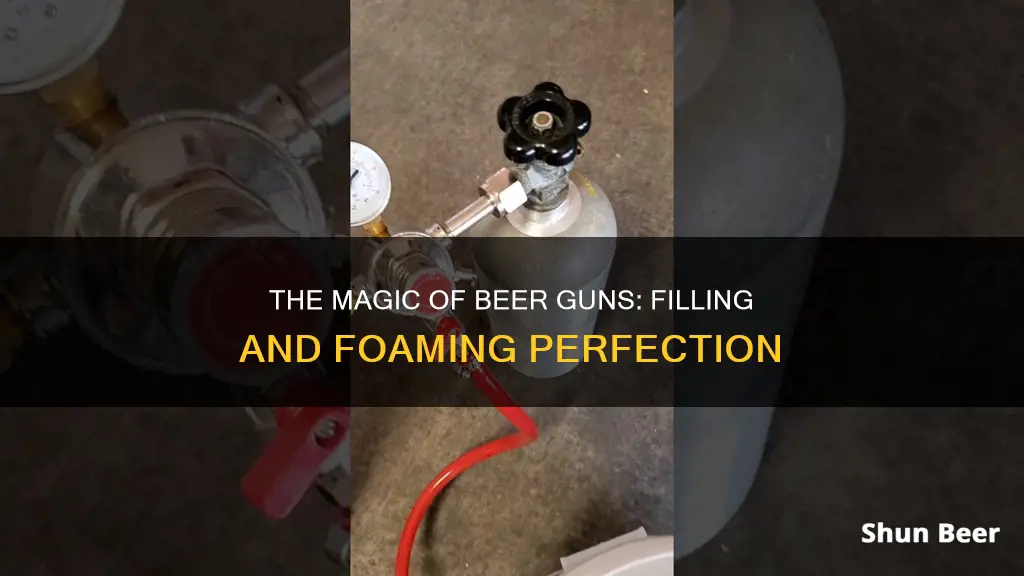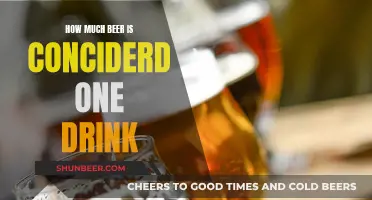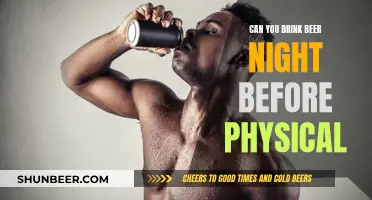
The Blichmann Beer Gun is a device that allows users to fill bottles with beer straight from a keg. The Beer Gun is designed to reduce beer from keg pressure to atmospheric pressure with little turbulence, providing a consistent bottle fill level every time. The Beer Gun is placed at the bottom of the bottle and gradually fills it up, keeping the stem full and reducing pressure changes and turbulence. The Beer Gun also has a CO2 purge feature, which helps to prevent oxidation during filling.
| Characteristics | Values |
|---|---|
| Main function | Filling bottles from a keg |
| Unique design | Gradually reduces beer from keg pressure to atmospheric pressure with little turbulence |
| Valve placement | At the bottom of the BeerGun so it is quickly immersed in the beer, keeps the stem full, and reduces pressure changes and turbulence |
| Operation | One-handed |
| Setup and cleaning | Easy |
| Suitability | Works for wine-makers |
| Filling technique | Bottom-up |
| CO2 | Used to purge the chilled, sanitized bottles |
| Trigger | Stud |
| Hose ID | Crucial for any good tap/keg bottling system |
| Bottle temperature | Chilled bottles to the same temp as the brew to keep foaming to a minimum |
What You'll Learn

Purging bottles with CO2
There are different methods for purging bottles with CO2. One method is to use a CO2 mini-injector to purge the bottles before filling them with beer from a bottling bucket. Another method is to use a beer gun, which is connected to a keg and used to fill bottles with beer. The beer gun has a CO2 jacketing tube that allows for bottle purging. By purging the bottles with CO2, the headspace in the bottle is filled with CO2 instead of oxygen, reducing the risk of oxidation.
When purging bottles with CO2, it is important to sanitise the bottles beforehand and to ensure that the CO2 and beer lines are also sanitised to prevent contamination. The bottles should be filled with beer slowly and steadily to avoid excessive foaming. It is also important to maintain consistent temperatures during the purging and filling process to minimise foaming.
Some brewers choose to purge the headspace of the bottle with CO2 after filling it with beer to ensure that any remaining oxygen is removed. This can be done by using the CO2 trigger on the beer gun or a separate CO2 source. Capping the bottles immediately after purging and filling helps to maintain carbonation and reduce oxygen exposure.
Overall, purging bottles with CO2 is an important step in the beer-making process, especially for beers that are susceptible to oxidation. By taking the time to purge bottles properly and maintaining sanitisation and temperature control, brewers can produce beers with improved flavour, aroma, and shelf life.
Mouthwash and Beer: Effective Mosquito Repellents or Old Wives' Tales?
You may want to see also

Reducing pressure changes and turbulence
The Blichmann BeerGun® is designed to reduce pressure changes and turbulence when filling bottles from a keg. The non-throttling, quick-acting valve is placed at the bottom of the BeerGun® so it is quickly immersed in the beer, keeping the stem full, and reducing pressure changes and turbulence. This design feature, along with the CO2 jacketing tube for bottle purging and ergonomic valve actuators, makes filling bottles faster, easier, and more precise.
To reduce pressure changes and turbulence when using the Blichmann BeerGun®, it is important to follow the correct setup and usage procedures. Here are some key steps and tips:
- Ensure that the BeerGun® and all its components are properly sanitised before use.
- Connect the BeerGun® to the keg using the liquid post. Keep the keg pressure below 15 psi, with 10 psi working well for a 10' beer line going to the gun.
- Connect the BeerGun® to a separate CO2 feed to purge the chilled, sanitised bottles before filling.
- When filling the bottles, start with the working end of the gun at the lowest point in the bottle and pull the main trigger to start the beer flowing. Get the tip under the brew as fast as possible and do not let go of the trigger until the bottle is filled.
- Fill the bottle until the beer is level with the top or until it overflows with foam. Removing the gun will help bring the beer level down to maintain carbonation.
- Cap the bottle immediately after filling to reduce oxygen exposure and maintain carbonation.
- Chill the bottles to the same temperature as the brew to keep foaming to a minimum.
By following these steps and utilising the unique design of the Blichmann BeerGun®, you can effectively reduce pressure changes and turbulence when bottling beer from a keg.
Beer and Bowel Movements: The Laxative Effect
You may want to see also

One-handed operation
The BeerGun® by Blichmann Engineering is designed for easy, one-handed operation. The BeerGun® is placed at the bottom of the bottle, which is then filled single-handedly, making it perfect for gatherings or holiday gifts. The BeerGun® uses advanced technology to prevent foam buildup, ensuring a repeatable, easy fill every time. Its unique design gradually reduces beer from keg pressure to atmospheric pressure, minimising turbulence and providing a consistent bottle fill level.
The ANWUYANG Stainless Bottle Filler Beer Gun is another example of a beer gun with one-handed operation. This beer gun eliminates the complicated operation and cleaning of traditional CP bottle fillers. It fills bottles with minimal foaming and carbonation loss, making the process faster, more intuitive, accurate, and easier.
Beer's Blood-Thinning Effect: Myth or Reality?
You may want to see also

Setup and cleaning
The Blichmann Beer Gun® is designed for easy setup and cleaning. It fills bottles with a one-handed, intuitive operation, simplifying the process compared to counter-pressure fillers. The Beer Gun® is made of stainless steel and can be disassembled for thorough cleaning.
To set up the Beer Gun®, follow these steps:
- Disassemble the Beer Gun® and sanitise the components. Soak the parts in sanitising solution and scrub them with a bottle brush. Rinse and dry the parts before reassembling.
- Connect the Beer Gun® to the keg using the liquid post. Keep the keg pressure below 15 psi, with 10 psi working well for a 10' beer line going to the gun.
- Connect the Beer Gun® to a CO2 feed to purge the chilled, sanitised bottles.
After bottling, turn off the regulator pressure and bleed off the keg pressure. Rinse out the keg and add a sanitiser solution. Re-pressurise the keg and push the solution through the Beer Gun® to sanitise both the keg and the Beer Gun®. Disassemble and sanitise the Beer Gun® again before storing.
Beer Fast: Does It Work Quickly?
You may want to see also

Filling bottles from the bottom
The BeerGun® is attached to the keg using the liquid post. The keg pressure should be kept under 15 psi, with 10 psi working well for a 10' beer line going to the gun. The gun is also connected to a CO2 feed, which is used to purge the chilled, sanitised bottles. The CO2 butterfly trigger is then pressed for about five seconds to purge the bottle of remaining drops of sanitising solution. The bottle is then tipped upright but kept at a slight angle, and the tip of the gun is placed in the bottom corner of the bottle. The filling trigger is then pulled, and the beer flows slowly and steadily, minimising foam. Once the beer level is even with the top of the bottle, the gun is removed, and the bottle is capped. The volume of the gun nozzle is designed so that filling to the top and removing the filler leaves the proper headspace in the bottle.
The BeerGun® is also designed for one-handed, intuitive operation, making it easier to use than counter-pressure fillers. It is also easy to set up and clean, with all components that come into contact with the beer made of stainless steel.
Morning Beer: Should You Drink Before Work?
You may want to see also
Frequently asked questions
A beer gun is a device that allows you to fill bottles with beer straight from a keg. It uses CO2 to push the beer into the bottles, and its unique design gradually reduces the beer from keg pressure to atmospheric pressure, minimising turbulence and providing a consistent bottle fill level.
The beer gun allows you to fill bottles with carbonated beer straight from a keg, eliminating the need for bottle fermentation and the long carbonation wait time. It also helps maintain the clarity of the beverage by reducing yeast sediment. Additionally, the beer gun can purge bottles with CO2 before filling, minimising oxygen and helping to preserve the carbonation and taste of the beer.
The setup process involves connecting the beer gun to a CO2 regulator and keg using gas and liquid lines. The specific steps may vary depending on your keg setup, but it typically involves attaching gas hoses to a flange or splitter and connecting the liquid line to the beer gun and keg. It is important to ensure that the pressure is set below 15 psi to prevent excessive foaming during bottling.
Once the beer gun is set up, you can begin bottling by purging sanitised bottles with CO2 and then filling them with beer from the keg. It is recommended to tilt the bottle at an angle during filling to control the foam and fill the bottle to the desired level. After filling, simply cap the bottles and store them in a cool, dark place.







